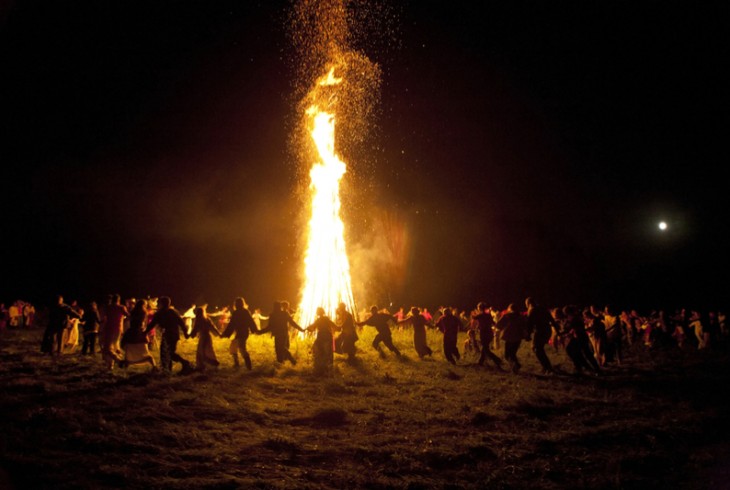
Christmas, as we know it today, is a holiday that commemorates the birth of Jesus Christ and is observed on December 25 by Christians around the world. However, the origins of Christmas and its traditions are not as straightforward as they seem. Many of the customs and practices associated with Christmas have their roots in pre-Christian pagan winter festivals. In this article, we will explore seven ways in which Christmas mirrors these ancient pagan festivals.
Winter Solstice Celebrations
The winter solstice, which typically falls on December 21 or 22 in the Northern Hemisphere, marks the shortest day of the year. Many ancient cultures celebrated this time of year with festivals to mark the return of the sun and the coming of longer days. These festivals often involved feasting, gift-giving, and merriment.
1. Yule Log and Fire Festivals

In many ancient cultures, the winter solstice was celebrated with fire festivals. The Celts, for example, would light a large log, known as the Yule Log, to symbolize the light and warmth of the sun. This tradition has been adopted into Christmas celebrations, where a Yule Log is often burned throughout the Twelve Days of Christmas.
Germanic and Nordic Traditions
The Germanic and Nordic peoples of Northern Europe had their own winter festivals, which were later influenced by Christianity. These festivals were often associated with the god Odin and the Wild Hunt, a procession of ghostly hunters through the sky.
2. Christmas Trees and Evergreen Branches

The evergreen fir tree was seen as a symbol of life and fertility by the ancient Germanic and Nordic peoples. They would bring evergreen branches into their homes during the winter solstice to symbolize the continuation of life and the hope for the return of the sun. This tradition has been adopted into Christmas celebrations, where Christmas trees are often decorated with lights, ornaments, and tinsel.
Roman and Greek Influences
The ancient Romans and Greeks also had their own winter festivals, which were later incorporated into Christmas celebrations.
3. Gift-Giving and Feasting

The ancient Romans celebrated the festival of Saturnalia in December, which involved gift-giving, feasting, and merriment. This tradition has been adopted into Christmas celebrations, where gifts are exchanged and feasts are held with family and friends.
Celtic and Druidic Influences
The ancient Celts and Druids also had their own winter festivals, which were later incorporated into Christmas celebrations.
4. Holly and Ivy

The ancient Celts and Druids believed that holly and ivy had magical powers and would bring good luck and protection during the winter months. These plants were often brought into homes during the winter solstice to symbolize the continuation of life and the hope for the return of the sun.
Winter Solstice Folklore
Many ancient cultures had folklore associated with the winter solstice, which has been incorporated into Christmas celebrations.
5. Krampus and the Wild Hunt

In many ancient cultures, the winter solstice was associated with the Wild Hunt, a procession of ghostly hunters through the sky. This folklore has been incorporated into Christmas celebrations, where Krampus, a half-goat, half-demon creature, is said to punish naughty children during the Christmas season.
Ancient Symbolism
Many ancient cultures had symbolism associated with the winter solstice, which has been incorporated into Christmas celebrations.
6. The Star of Bethlehem

The ancient Mesopotamians believed that the star Sirius, also known as the Star of Bethlehem, was a symbol of the sun god and the hope for the return of the sun. This symbolism has been incorporated into Christmas celebrations, where the Star of Bethlehem is often depicted in nativity scenes.
Pagan Winter Festivals Today
Many modern pagans and Wiccans still celebrate the winter solstice with festivals and rituals.
7. Yule and the Wheel of the Year

Many modern pagans and Wiccans celebrate the winter solstice as Yule, one of the eight Sabbats on the Wheel of the Year. This festival marks the rebirth of the sun and the hope for the return of longer days.




We hope this article has given you a deeper understanding of the origins of Christmas and its connections to pagan winter festivals. Whether you celebrate Christmas or Yule, we wish you a joyful and festive holiday season.
What is the significance of the winter solstice?
+The winter solstice marks the shortest day of the year and the beginning of the lengthening of days. It has been a significant event in many ancient cultures, often celebrated with festivals and rituals to mark the return of the sun.
How did Christmas become associated with December 25?
+Christmas became associated with December 25 in the 4th century, when Pope Julius I chose this date to commemorate the birth of Jesus Christ. This date coincided with the existing Roman festival of Sol Invictus, which celebrated the sun god.
What is the connection between Christmas and pagan winter festivals?
+Many of the customs and practices associated with Christmas have their roots in pre-Christian pagan winter festivals. These festivals often involved feasting, gift-giving, and merriment, and were celebrated around the winter solstice.











